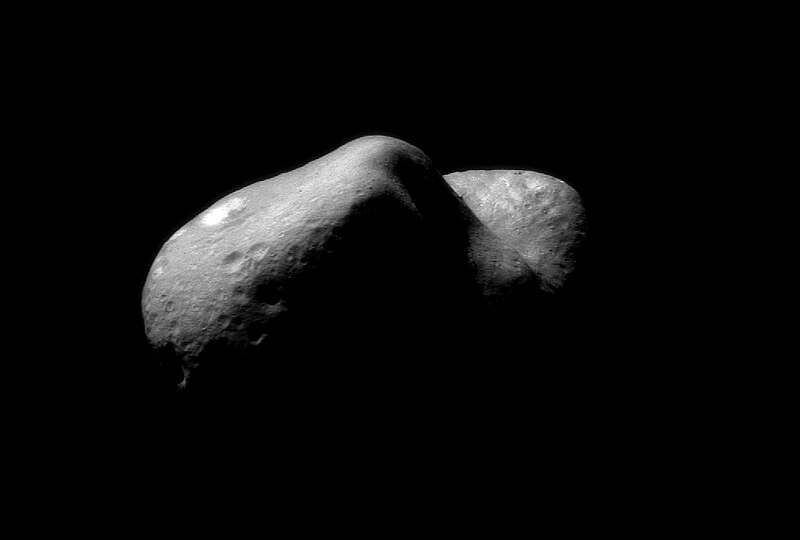
Asteroids, sometimes called minor planets or planetoids, are small Solar System bodies in orbit around the Sun, especially in the inner Solar System; they are smaller than planets but larger than meteoroids. The term "asteroid" has historically been applied primarily to minor planets of the inner Solar System, as the outer Solar System was poorly known when it came into common usage. The distinction between asteroids and comets is made on visual appearance: Comets show a perceptible coma while asteroids do not.
Traditionally, small bodies orbiting the Sun were classified as asteroids, comets or meteoroids, with anything smaller than ten metres across being called a meteoroid. The term "asteroid" is ill-defined. It never had a formal definition, with the broader term minor planet being preferred by the International Astronomical Union until 2006, when the term "small Solar System body" (SSSB) was introduced to cover both minor planets and comets. The 2006 definition of SSSB says that they "include most of the Solar System asteroids, most trans-Neptunian objects (TNOs), comets, and other small bodies".
It is believed that planetesimals in the main asteroid belt evolved much like the rest of the Solar Nebula until Jupiter neared its current mass, at which point excitation from orbital resonances with Jupiter ejected over 99% of planetesimals in the belt. Simulations and a discontinuity in spin rate and spectral properties suggest that asteroids larger than approximately 120 km (75 mi) in diameter accreted during that early era, whereas smaller bodies are fragments from collisions between asteroids during or after the Jovian disruption. At least two asteroids, Ceres and Vesta, grew large enough to melt and differentiate, with heavy metallic elements sinking to the core, leaving rocky minerals in the crust.
In the Nice model, many Kuiper Belt objects are captured in the outer Main Belt, at distances greater than 2.6 AU. Most were later ejected by Jupiter, but those that remained may be the D-type asteroids, and possibly include Ceres.

Asteroids contain traces of amino-acids and other organic compounds, and some speculate that asteroid impacts may have seeded the early Earth with the chemicals necessary to initiate life, or may have even brought life itself to Earth.

Only one asteroid, 4 Vesta, which has a reflective surface, is normally visible to the naked eye, and this only in very dark skies when it is favorably positioned.

The majority of known asteroids orbit within the main asteroid belt between the orbits of Mars and Jupiter, generally in relatively low-eccentricity (i.e., not very elongated) orbits. This belt is now estimated to contain between 1.1 and 1.9 million asteroids larger than 1 km (0.6 mi) in diameter, and millions of smaller ones. These asteroids may be remnants of the protoplanetary disk, and in this region the accretion of planetesimals into planets during the formative period of the solar system was prevented by large gravitational perturbations by Jupiter. Although fewer Trojan asteroids sharing Jupiter's orbit are known, it is thought that there are as many as there are asteroids in the main belt.
The dwarf planet Ceres is the largest object in the asteroid belt, with a diameter of over 975 km (606 mi). The next largest are the asteroids 2 Pallas and 4 Vesta, both with diameters of over 500 km (311 mi). Normally Vesta is the only main belt asteroid that can, on occasion, become visible to the naked eye. However, on some rare occasions, a near-Earth asteroid may briefly become visible without technical aid; see 99942 Apophis.
The mass of all the objects of the Main asteroid belt, lying between the orbits of Mars and Jupiter, is estimated to be about 3.0-3.6 × 1021 kg, or about 4 percent of the mass of the Moon. Of this, Ceres comprises 0.95 × 1021 kg, some 32 percent of the total. Adding in the next three most massive objects, Vesta (9%), Pallas (7%), and Hygiea (3%), brings this figure up to 51%; while the three after that, 511 Davida (1.2%), 704 Interamnia (1.0%), and 52 Europa (0.9%), only add another 3% to the total mass. The number of asteroids then increases rapidly as their individual masses decrease.
No comments:
Post a Comment
Note: Only a member of this blog may post a comment.